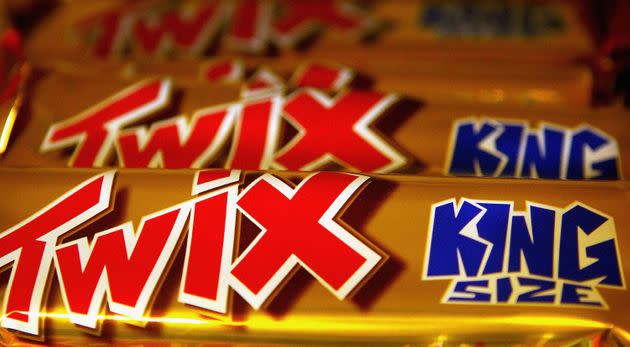The Halloween Candy You Give Out Reveals How Much You Care About Status

Halloween is approaching and it’s time to buy the candy you pass out to trick-or-treaters. But if you want to have the best candy on the block, which kinds do you choose? Turns out, there’s more psychology behind it than you think.
Many stores began stocking Halloween candy back in early September, because Halloween candy is big business: The National Confectioners Association reports that confectionery retail sales for the holiday were $4 billion in 2020, calling the holiday its Super Bowl. In a survey this past summer, it found that 87% of people plan to buy the same amount of candy (or more) than the prior year, up from 80%.
But what are the most sought-after types of candy that’ll keep you in good standing with the neighborhood kids? Should you go wild and buy king-size candy bars to curry favor? Or do you go for super-sour candies that are popular with certain ages of trick-or-treaters? And more importantly, why do you even care about being the house that stocks good treats? We spoke with experts and learned that when it comes to Halloween candy, there’s much more than meets the eye.
Why do we even eat candy at Halloween?
Beth Kimmerle, a candy historian and taste expert, says our Halloween candy habit comes from harvest traditions to prepare for the winter. Before the advent of refrigeration and grocery stores stocked all year round, people had to harvest their food and preserve it for the long winter. Sugar, in addition to salt, makes a great preservative. Fast-forward to the 20th century and it became a time to make and enjoy lots of sweets. With the rise of packaged goods and candy companies seizing on Halloween’s marketing opportunity, the holiday has evolved from a time of year to make candy into a time of year to eat it, Kimmerle noted.
And while candy is a nutritional no-no throughout most of the year, Halloween makes us all a little more open to it. “Around Halloween, it’s one of the only times it [becomes a] permissible treat,” Kimmerle said. “Typically it’s not as permissible at other times of the year. But Halloween makes it OK to buy lots of candy.”
Pick your poison
With so many types of candy available during Halloween, children have created a hierarchy of the most desirable treats. King-size chocolate bars are often at the top, Kimmerle noted, because they’re so much larger than other bars and because parents don’t often let their kids indulge in a candy bar that big.
For trick-or-treaters ages 8-12, non-chocolate candy is usually next on the hierarchy, Kimmerle said. (Parents prefer chocolate more than kids and might favor chocolate options when they purchase candy, but kids often want non-chocolate candies, like Sour Patch Kids.) “Kids really seek out sour and extreme flavors,” she said. “Again, something that they may not be able to get on a regular basis.” Kids’ third favorite would then typically be chocolate.

Interestingly enough, the NCA’s recent consumer survey shows that the top three candy categories purchased at Halloween in the U.S. are chocolate, gummies and candy corn ― which signals that adults may be buying the chocolate more for themselves than the trick-or-treaters.
Then there’s the question of buying branded candy vs. generic or lesser-known candy. Kids want branded candy in part due to marketing, noted psychotherapist Michelle Maidenberg, because that’s what they are used to seeing. Kimmerle added that buying branded candy might be an effort to people-please ― there’s a fear that if you hand out subpar candy, your reputation in the neighborhood will take a nosedive (or worse, your house could get egged).
For trick-or-treaters, sometimes it’s more about acquiring the candy than eating it
While most people associate Halloween with eating as much candy as one can, many trick-or-treaters are more interested in acquiring candy, not eating it. Maidenberg previously conducted an informal survey of 30 children ages 6-16 about the most enjoyable part of the holiday. She found that dressing in costumes and hanging out with friends was first, followed by candy accumulation. Eating lots of candy came third.
You’ll often see kids bring a pillow case to collect as much candy as they can and at the end of the night, they’ll dump it out to see what they got. Kimmerle noted that it’s rare for most children to see that much candy all at once, triggering their reward center before they even eat any. “You’re all of a sudden Willy Wonka and owning a candy store at that point,” Kimmerle noted. In her experience, children generally lose interest in eating it after counting the pieces.
At the end of the day, the candy you pass out is a status marker
If you’re buying candy for trick-or-treaters, you ultimately have to decide which direction you want to go. Do you want to be known as the king-size candy house? Or the house with all the sour candy? Do you want to be the house with never-ending candy? Or perhaps you’re the house that hands out apples and boxes of raisins? (But that’s not the case for most of us.)
Kimmerle sees your choice of candy as a status marker. “It’s a reflection of who you are and who you want to be,” she noted. Most people will likely opt for something in the middle or select candies that the candy-buyer and their family likes.
What kind of house will you be this Halloween?
This article originally appeared on HuffPost and has been updated.

 Yahoo Finance
Yahoo Finance 


